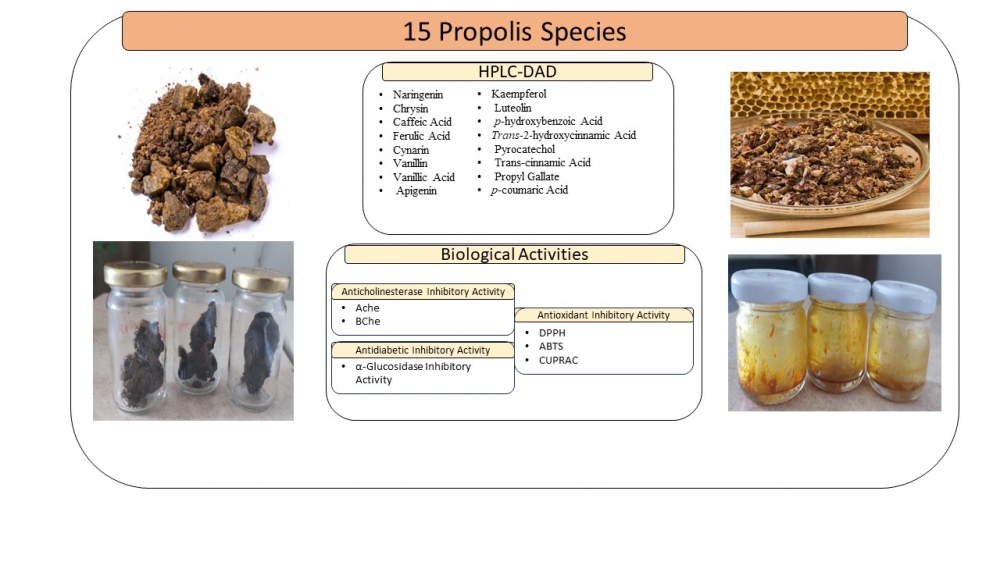JOURNAL 3101
Records of Agricultural and Food Chemistry
Year: 2024 Issue: 3 Special Issue: Abstracts 3rd. TCS, International Food Chemistry Congress February 29-March 03,2024 Antalya Türkiye
p.36 - 36
Viewed 892 times.
GRAPHICAL ABSTRACT

ABSTRACT
Propolis is a natural substance collected by honeybees from the environment. It is gathered from plants such as poplar, palm, pine, conifer secretions, gums, resins, mucilage, and leaf buds. The typical composition of raw propolis is 50% plant resins, 30% waxes, 10% essential and aromatic oils, and other organic compounds. The scientists focused on propolis chemistry and its bioactivities in the last two decades. The literature revealed that propolis is practical and can prevent and treat colds. It has also been reported that propolis has diverse bioactivities, including anti-inflammatory, antimicrobial, antioxidant, antitumor, antiulcer, and anti-HIV activities. Therefore, it is suggested to use it against wounds and ulcers, rheumatism, sprains, heart disease, diabetes, and dental caries. Modern medical treatments have recently suggested propolis usage due to its well-investigated chemical composition. Until 2000, over 300 chemical components belonging to the flavonoids, terpenes, and phenolics have been identified in propolis [1]. The Turkish propolis samples collected from 15 regions of Türkiye were extracted using 95% ethanol. After drying, the extracts were analyzed for their chemical ingredients using HPLC-DAD coupled with a C18 (5 µm, 4.6 mm x 250 mm) column [2]. Antioxidant (DPPH, ABTS, CUPRAC) activity, anticholinesterase (AChE and BChE), and α-glucosidase inhibition and α-amylase inhibition activity methods were also used for these extracts. According to the HPLC, naringenin (ranged from 10.64 to 103.89 mg/g), chrysin (ranged from 0.88 and 42.97 mg/g), caffeic acid (ranged from 1.81 and 14.33 mg/g), ferulic acid (ranged from 0.1 and 11.33 mg/g), and cynarin (ranged from 6.44 and 16.61 mg/g) were in reasonable amounts. Other compounds, such as vanillin, vanillic acid, apigenin, p-coumaric acid, kaempferol, luteolin, p-hydroxybenzoic acid, trans-2-hydroxycinnamic acid, pyrocatechol, trans-cinnamic acid, and propyl gallate were also quantified. The extracts exhibited spectacular antioxidant activity in DPPH, ABTS, and CUPRAC assays. Moreover, they exhibited AChE significant inhibitory activity (IC50 ranged from 39.77±3.01 and 449.35±0.75 mg/mL). BChE inhibitory activity (IC50 ranged from 6.55±3.16 and 30.92±8.53 mg/mL). and a-glucosidase inhibitory activity (IC50 ranged from 27.06±3.92 and 256.93±16.25 mg/mL). To reveal the possible use of propolis against Alzheimer's disease and antidiabetes, further studies should be performed. The continuing future search is to identify the responsible inhibitory compounds for AChE, BChE, and a-glucosidase.
KEYWORDS- Propolis
- flavonoid
- phenolic compounds
- HPLC-DAD
- antioxidant activity
- anticholinesterase activity